Abstract
A comparison of three types of ionosonde data from Europe during an interplanetary coronal mass ejection (ICME)- and a corotating interaction region (CIR)-driven geomagnetic storm event is detailed in this study. The selected events are 16–20 March 2015 for the ICME-driven storm and 30 May to 4 June 2013 for the CIR-driven one. Ionospheric data from three European ionosonde stations, namely Pruhonice (PQ), Sopron (SO) and Rome (RO), are investigated. The ionospheric F2-layer responses to these geomagnetic events are analyzed with the ionospheric foF2 and h’F2 parameters, the calculated deltafoF2 and deltahF2 values, the ratio of total electron content (rTEC) and Thermosphere, Ionosphere, Mesosphere, Energetics and Dynamics (TIMED) satellite Global Ultraviolet Imager (GUVI) thermospheric [O]/[N2] measurement data. The storm-time and the quiet-day mean values are also compared, and it can be concluded that the quiet-day curves are similar at all the stations while the storm-time ones show the latitudinal dependence during the development of the storm. As a result of the electron density comparison, during the two events, it can be concluded that the sudden storm commencement (SSC) that characterized the ICME induced a traveling atmospheric disturbance (TAD) seen in the European stations in the main phase, while this is not seen in the CIR-driven ionospheric storm, which shows a stronger and more prolonged negative effect in all the stations, probably due to the season and the depleted O/N2 ratio.
Keywords:
space weather; geomagnetic storms; ionosphere; ionospheric storm; ICME; CIR; ionosonde; Digisonde 1. Introduction
Within the Earth’s plasma environment (ionosphere, plasmasphere, magnetosphere), all the regions are closely connected. Due to external forcing, perturbations can be observed in the individual plasma layers. All the physical effects that cause measurable changes in the solar wind (SW), the outer and inner magnetosphere, the ionosphere, and the thermosphere around the Earth are called space weather processes. The space weather events, like the interplanetary coronal mass ejections (ICME-induced events) and the corotating interaction regions (CIRs) accompanying with the high-speed solar wind streams (HSSWS) [] that arrive at our Earth cause a so-called geomagnetic storm in the plasma environment of the planet. There were many studies that dealt with the identification and geoeffectiveness of these two types of geomagnetic storms (see e.g., [,,,,,,,,,,,,,]).
The first discoveries of the CMEs were in the early 1970s [], and their preliminary name was coronal transients. After previous studies, it is known that a typical CME consists of three parts: a bright frontal loop, a cavity, and then a bright core at the center. When the shock ahead of a fast ICME reaches the Earth’s magnetosphere, it creates a sudden increase in the Dst index [], which is due to the compression of the magnetosphere caused by the passage of a shock in the solar wind [,] and manifests as a sudden impulse (SI+)/sudden storm commencement (SSC) phase [] in the ground-based geomagnetic measurements. According to the literature, the definition of the sudden impulse (SI) is a sharp change in the geomagnetic field, and its onset is recorded within about 1 min all over the world []. We can talk about positive SI (SI+) and negative SI (SI−), which are characterized by a global increase or decrease in the horizontal component (H) of the geomagnetic field, respectively []. In past studies, it has been found that SI+ is always caused by fast forward (FF) shocks, while SI- is caused by fast reverse (FR) shocks []. Chapman and Ferraro [] made the first assumption that SSC is the manifestation of the arrival of a charged particle stream originating from the Sun. Generally, when an impressive SI (mostly SI+) precedes a geomagnetic storm due to intense IMF Bz components, it is called storm sudden commencement (SSC or SC) []. Tsurutani et al. [] found that the origins of the interplanetary southward Bz events are quite varied. In addition, they highlighted that sheath fields, draped fields and driver gas fields have equal importance in the generation of major geomagnetic storms. Fast ICMEs produces SI+ shocks, but they are not followed by geomagnetic storms if they are not accompanied by an intense southward Bz period []. Slow ICMEs can also cause geomagnetic storms if they have southward IMF Bz components; however, they are not fast enough to produce a shock []. In the literature, we found the use of SI, SSC and SC also with lowercase letters like si or the combination of capital and lowercase letters, e.g., Si; however, no fundamental difference has been detected between these morphologies [].
The CIRs are associated with polar coronal holes in the Sun [,], and when fast wind streams catch up with slow wind, their collision forms corotating interaction regions []. As the coronal holes rotate along with the Sun, fast streams and occasional shock waves at the CIRs hit the Earth’s magnetosphere, producing recurrent storms, with Dst ≥ −100 nT in most cases (see more about it in [,,,,,,,,,,,]). The CIR-driven geomagnetic storms are typically not led by an FF shock so there is no positive sudden impulse (SI+)/sudden storm commencement (SSC) phase []; however, the impact of the generated effects sometimes can be larger than the ICME-induced ones (see [,,]). The background explanation for that is the fact that the CIRs and the following HSSWS have a longer duration, and as a result, they can deposit roughly the same amount or even more energy into the upper atmosphere than most of the moderate ICME storms do over the entire period of their course [,,,,,,,]. The magnitude of these type of geomagnetic storms is usually weak to moderate, which is connected to the highly oscillatory nature of the GSM magnetic field z component within CIRs [,,,].
There is an accompanying event right after the CIRs’ front shock, when the high-speed solar wind streams (can be called as HSS or HSSWSs) inject energy into the magnetosphere as a chain of consecutive substorms, which are caused by the southward component of large-amplitude Alfvén waves (within the body of CIRs) []. The triggered auroral activity was named high-intensity (AE > 1000 nT) and long-duration (more than 2 days) continuous auroral activity events (HILDCAAs) by Tsurutani []. HILDCAAs often occur during the recovery phase of the geomagnetic storms, which can lead to an unusually long recovery phase []. According to the recent review paper by Tsurutani et al. [], it is not really a storm recovery phase since more energy is being injected into the magnetosphere during this interval. The HILDCAA interval can last days to weeks.
During a geomagnetic storm event, perturbations appear in the ionospheric layers, which are called ionospheric storms, and their effects can be observed for 1–10 days. Respecting a quiet day value, a positive (electron density increase) and a negative (electron density decrease) ionospheric storm phase can be observed in the ionospheric layers during geomagnetically disturbed conditions. There are several processes that have to be considered during the examination of the mid- and low-latitude ionosphere during these events, namely photo-production, chemical loss and transport by thermal expansion, neutral winds, waves, tides and electric fields of internal and external origin, like prompt penetration of magnetospheric convection electric field (PPEF) and disturbance dynamo electric field (DDEF) [,,,]. The electron density of the ionospheric F2-layer is, approximately, directly proportional to the thermospheric O/N2 ratio [,]; therefore, during ionospheric studies, the variation of this parameter is crucial. If other conditions are unchanged, we should detect an electron density decrease (negative phase) in the ionospheric F-region, where the O/N2 ratio is decreased; on the contrary, when the O/N2 ratio is increased, a positive phase should be detected in the F-layer electron density [].
In addition, several other influencing factors must be taken into consideration during the analysis of the events, such as the geomagnetic storm intensity, local time (LT) of the SSC and of the storm evolution, season, geomagnetic latitude and longitude, past history of geomagnetic activity, and the state of the ionosphere–thermosphere system ([,,]). In addition, the ionospheric F-layer plasma is considered the base of the plasmasphere []. During geomagnetic storms, the ionospheric footprint of the plasmapause (PP), which is tightly coupled to the minimum of the midlatitude/main ionospheric trough (MIT), as stated by Heilig et al. [], often moves to midlatitudes, especially after sunset. This equatorward movement of the MIT (and so the PP) is manifested as a negative ionospheric storm phase in the F-layer []. The plasmasphere can remain conjugated with the midlatitude ionosphere during daytime hours, thus contributing to the daytime positive ionospheric F-layer storm phase as the result of the local noon to dusk dynamical plasmaspheric processes []. See more about the MIT and its morphology in [,,,,,,].
The Earth’s plasma environment is a very complex, tightly coupled system; therefore, the observed ionospheric perturbations and features must be considered a part of this system. The general evolution of the midlatitude ionospheric storms was described by Rishbeth et al. [] and summarized by Prölss [] (see also the reviews and case studies of [,,,,,,,,,,]). However, the ICME- and CIR-induced geomagnetic storms have different time courses; therefore, they result in different magnitudes of ionospheric perturbations []. This is the reason why we have to better describe the ionospheric evolution of these two types of geomagnetic storms.
The main aim of this study is to compare the ionospheric responses observed at the three European ionospheric stations considered and the different ionosonde instruments during the two geomagnetic storms associated with the two different solar sources: ICME and CIR events. Using also the thermospheric [O]/[N2] and ratio of Total Electron Content (rTEC) difference data, we explore the underlying mechanism during the course of the events.
Since the exact effect mechanisms are not yet known, case studies like this can provide new results. Deepening our knowledge in this research area is of high importance if we want to predict the impact of space weather events.
2. Materials and Methods
2.1. Materials
To perform this study, we have selected an intense CIR- and ICME-induced event, where Dstmin < −100 nT []. Three ionosonde stations from Europe, namely Pruhonice (PQ), Sopron (SO) and Rome (RO), were used to also examine the latitudinal differences during the course of the storms (Table 1). The ionosonde stations had different types of instruments during the examined events: PQ operates a DPS-4D type, SO had a polish (VISRC-2) type and RO operates both a DPS-4 and an Advanced Ionospheric Sounder (AIS-INGV) type of ionosonde. The AIS-INGV ionosonde was developed in the Laboratorio di Geofisica Ambientale at the Istituto Nazionale di Geofisica e Vulcanologia (INGV) and designed both for research and for routine monitoring ([,,]). Both RO ionosondes provide real-time digital ionograms, along with automatically scaled parameters []. Manually scaled data, curated by an experienced operator, are also available for retrospective studies [].

Table 1.
The information about the three ionospheric stations considered in this study. For the geomagnetic coordinates, the International Geomagnetic Reference Field (IGRF-13) model-based calculator (for the year 2015) was used.
From the ionosonde measurements, we used the foF2 (which describes the maximum electron density in the F2-layer), the h’F2 (virtual height of the F2-layer), the maximum usable frequency (MUF) and isodensity data with 15/30 min time resolution. The ionosonde data used in this study were fully manually scaled by the authors. The Digisonde instruments (DPS-4 and -4D type) use a built-in ARTIST-5 autoscaling tool, and with SAO Explorer interactive software 5.0 version, we can produce from the measured ionogram parameters several products, like it can calculate the MUF, hmF2, profilogram, contours, etc. Isodensity data show the height variation of a given measured frequency. Note that for the data of the AIS-INGV and of the VISRC-2 type of ionosonde, we could not produce MUF and isodensity plots due to the fact that the Artist software only handles the data of the DPS type of ionosondes.
The TIMED satellite’s GUVI instrument data used in this study provide, at the altitude range of 60–180 km, the dayside [O]/[N2] and temperature profile as well as the auroral energy input. The global map of measurements can be derived from 14.9 daily orbits (see more in [,,]).
To gain clearer insight into the evolution of the storms, we also utilized global maps of the ratio of the total electron content (rTEC). On these maps, the differences between the observed TEC and the monthly averaged quiet TEC (normalized by the average TEC) are displayed. These maps are constructed by the National Institute of Information and Technology (NICT) using RINEX files.
2.2. Methods
Beside the above detailed data, we have computed the deltafoF2 = ∆foF2 and the deltahF2 = ∆h’F2 values (in percentages). For this, we used Equation (1) (given for deltafoF2), which is accepted and also generally used by other authors (e.g., [,,]):
This equation for deltafoF2/deltahF2 provides the relative foF2/h’F2 parameter deviation from the mean value of three quiet days (the three quietest days of each month, see Table 2).

Table 2.
Information about the two examined storms.
3. Results
3.1. Interplanetary and Geomagnetic Conditions
The main background information about the selected ICME- and CIR-driven events is listed in Table 2. In this case, both storms have an SSC date, and the Dstmin < −100 nT, representing an intense strength level. By CIRs, this is a rare scenario. It is hard to find such a good example for a comparison. In Figure 1, the condition of the interplanetary medium, represented by the interplanetary magnetic field (IMF) Bz component and the SW speed parameter, is displayed during both storms. To see a detailed picture, in Figure 2, we also plotted the evolution of the geomagnetic Dst, AE and Kp indices. The 2015 ICME-driven storm event is the so-called St. Patrick’s Day event, which caused the biggest geomagnetic storm in solar cycle 24. Several studies were published about this event and its generated processes in the thermosphere-ionosphere-plasmasphere [,,,,,,,,,,,,].
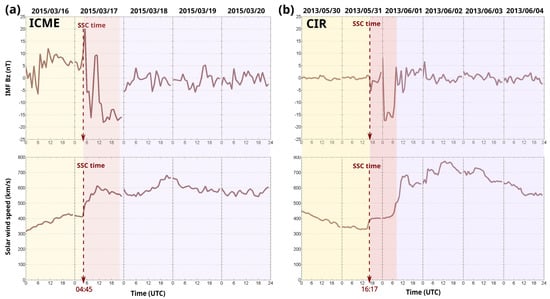
Figure 1.
The conditions of the interplanetary medium, namely the IMF Bz component on the upper plots and the solar wind speed on the lower plots, are portrayed. (a) The ICME-driven storm from 2015 March, and (b) the CIR-driven storm from 2013 June. The UT of the SSC (marked with horizontal red dotted lines) was at 16:17 for the 2013 storm and at 04:45 for the 2015 storm. The pre-storm phase is shaded with light yellow, the main phase is shaded with light red and the recovery phase is shaded with light purple color.
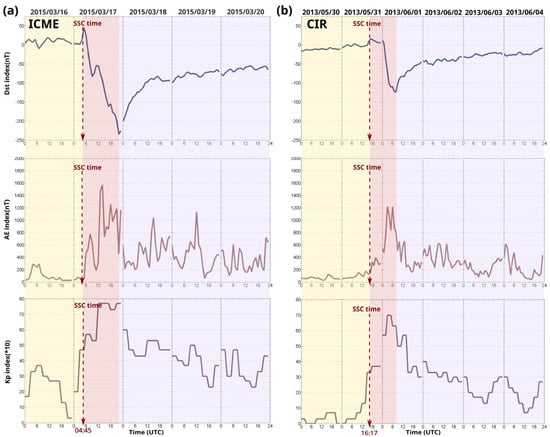
Figure 2.
The geomagnetic Dst, AE and Kp indices (starting from the top) are plotted in this figure. (a) The ICME-driven storm from 2015 March, and (b) the CIR-driven storm from 2013 June. The UT of the SSC (marked with horizontal red dotted lines) was at 16:17 for the 2013 storm and at 04:45 for the 2015 storm. The pre-storm phase is shaded with light yellow, the main phase is shaded with light red and the recovery phase is shaded with light purple color.
As for the geomagnetic storm phases, the pre-storm phase was on 16 March 2015 and on 31 May 2013 until the SSC time. The main phase lasted until 23:00 UT on 17 March 2015 and 09:00 UT on 1 June 2013, as detected in the Dst index (Figure 2). Then, the recovery phase started. However, by this CIR storm case in the SW speed data, a long-lasting high-speed solar wind stream period (HSSW) period can be seen starting from 12 UT on 1 June 2013; therefore, we cannot speak about a recovery phase as HSSW continuous energy injection is present in the auroral region. In Figure 1 and Figure 2, the pre-storm phase is shaded with light yellow, the main phase is shaded with light red and the recovery phase is shaded with light purple color.
The time interval of the ionospheric storm phases can be different. Right after the SSC, the main phase of the ionospheric storm starts, followed by the recovery phase. A detailed analysis of an interesting exception is reported in []. However, in these current cases, the geomagnetic and ionospheric storm phases went together, meaning no delay was observed.
3.2. Comparison of the Ionosonde Instruments
One of the aims of this study is to examine the differences and similarities between the three different types of ionosonde instruments: the AIS-INGV, the DPS-4, the DPS-4D and the VISRC-2. For this, we analyzed the calculated reference values for all the stations and both months. Moreover, we compared the two different ionosonde instruments of the Rome (RO) station.
In Figure 3, a comparison of the calculated three quiet-day means of the foF2 and hF2 parameters can be seen for all three stations, by both storms, where Figure 3a is for the 2015 event and Figure 3b is for the 2013 event. No significant deviation can be seen in these plots when we are comparing the data of the different stations. The foF2 quiet mean curve used for the ICME storm shows the typical diurnal behavior and oscillates between 4 and 10.5 MHz values around noon; on the other hand, the other foF2 mean curve is flatter and oscillates between 5 and 9 MHz.
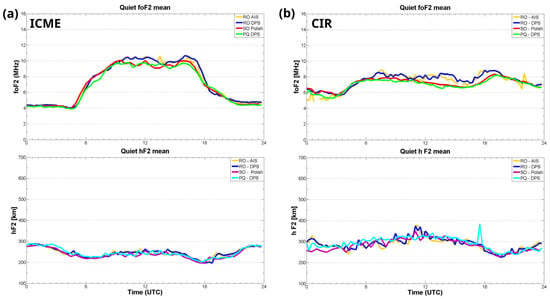
Figure 3.
The calculated three quiet-day means of the foF2 and hF2 parameters for all three stations, by both storms, where (a) shows the reference mean values from 2015 March and (b) shows the reference mean values from 2013 June.
In Figure 4, the measured foF2 and h’F2 parameter data from the DPS and AIS types of ionosondes are plotted for comparison. Figure 4a plots the ICME-driven event and Figure 4b plots the CIR-driven event. The instruments are co-located at the INGV headquarters in Rome and no significant deviation can be seen in the data.
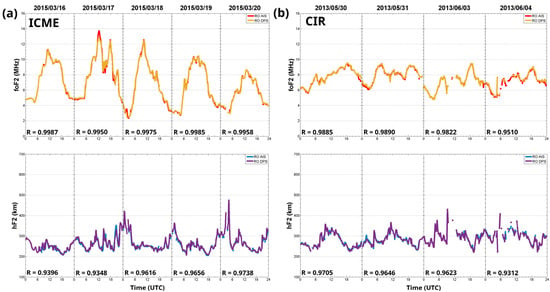
Figure 4.
The foF2 and h’F2 parameter comparison between the two ionosondes in the Rome (Italy) ionospheric observatory: RO041 (DPS type) and RM041 (AIS type) during the (a) ICME- and (b) CIR-driven storms. Data for 1–2 June 2013 are not displayed in this figure due a lack of AIS-INGV data during the whole day (see the whole RO DPS data in Figure 5 and Figure 6). The calculated correlation coefficient (R) values are displayed in the bottom left side of each plot.
It can be concluded that there is no significant difference between the RO AIS and DPS types of ionosonde instrument, given that the calculated correlation coefficient (R) values are between 0.9312 and 0.9987 (see Figure 4); therefore, in the following plots in the next section, we are only showing the DPS data.
3.3. Comparison of the ICME- and the CIR-Driven Ionospheric Storm Cases
The other aim of this study is to compare the ionospheric evolution of two types of geomagnetic storms (ICME and CIR) with ionosonde, TIMED/GUVI [O]/[N2] and rTEC data. For this, we calculated deltafoF2 and deltahF2, in percentages, according to Equation (1), which displays the deviations from the quiet-day reference values. When the value in Figure 5 and Figure 6 is 0%, the storm time value is equal to the median quiet-day value at the respective half hour [,].
In Figure 5 and Figure 6, the calculated deltafoF2 and deltahF2 values are displayed for (a) the ICME- and (b) CIR-driven events in both figures. After the SSC by the ICME-driven event, the deltafoF2 parameter increased up to 25% at RO and PQ, 35% at SO around noon and went up to 80% at RO, 30% at SO and 10% from 16–21 UT on 17 March, followed by a sharp decrease of 45–55% during the night until 06 UT on 18 March. As in [], we found this double peak feature in the foF2 parameter was around noon, with only half an hour delay at each station (namely Juliusruh (JR), Pruhonice (PQ), Sopron (SO), Rome (RO), Athens (AT)), while the second peak was observed at 17 h in JR data and at 18 h in AT data. As we concluded in the previous study, this double peak feature could be connected to the equatorward movement of the PPEF, which was induced during significant southward IMF Bz turning periods around 8 and 14 UT (see Figure 1) [,]. At the same time, the deltahF2 parameter is significantly increased, reaching 110% at PQ around 21 UT on 17 March. From 18 UT on 17 March until 15 UT on 18 March, these data show significant latitude dependence (see Figure 6). The nighttime latitude dependence is most probably connected to the equatorward movement of the main ionospheric trough (MIT) as discussed in our previous multi-instrumental study []. In addition, the storm-generated equatorward traveling atmospheric disturbances (TADs) also could have contributed to the latitude dependence in the deltahF2, as strong energy injection was registered in the AE index with around 1200 nT from 18 UT until 24 UT, as can be seen in Figure 2. On the other hand, by the CIR-driven event, the deltafoF2 parameter is significantly decreased up to −40% for a whole day from about 03 UT on 1 June until 06 UT on 2 June, with no latitude dependence. At the same time, the deltahF2 parameter is significantly increased, with visible latitude dependence, and PQ station deltahF2 data reaches 150%, indicating significant F2-layer uplifting.
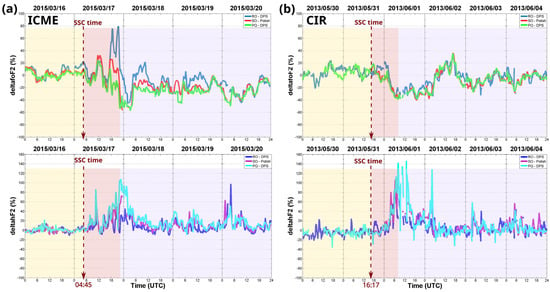
Figure 5.
DeltafoF2 (top) and deltahF2 (bottom) parameter comparison during the (a) ICME- and (b) CIR-driven geomagnetic storms. The UT of the SSC was at 16:17 for the 2013 storm and at 04:45 for the 2015 storm, marked with red dotted lines. The pre-storm phase is shaded with light yellow, the main phase is shaded with light red and the recovery phase is shaded with light purple color.
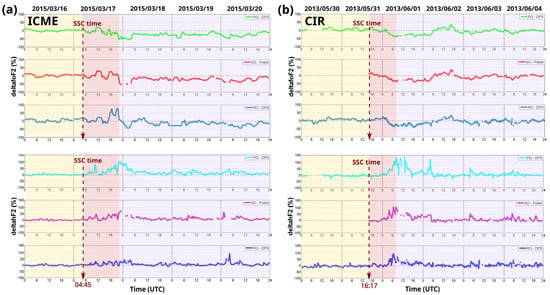
Figure 6.
The latitude dependence in the deltafoF2 (top) and deltahF2 (bottom) parameters during the (a) ICME- and (b) CIR-driven geomagnetic storms. The UT of the SSC was at 16:17 for the 2013 storm and at 04:45 for the 2015 storm, marked with red dotted lines. The pre-storm phase is shaded with light yellow, the main phase is shaded with light red and the recovery phase is shaded with light purple color.
In Figure 7, the reference [O]/[N2] data are displayed. The background condition and the seasonal differences can be clearly seen in these plots. During summer in the Northern Hemisphere, the background solar EUV-driven thermospheric meridional circulation causes a depleted [O]/[N2] ratio (indicated with blue on the figures), while at the equinox, the background condition shows a slight increase (yellow color) in [O]/[N2] in the Northern Hemisphere (see, for more, []).
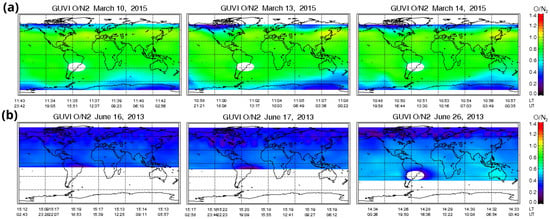
Figure 7.
TIMED/GUVI [O]/[N2] data on the reference days for the (a) 2013 and (b) 2015 storm cases.
In Figure 8, the storm-time [O]/[N2] data can be seen. Figure 8a plots the ICME-driven case, where on 17 and 18 March, during the main and early recovery phases of the geomagnetic storm, the depletion in the [O]/[N2] ratio during the night can be observed over Europe. On the other hand, a depletion in the [O]/[N2] ratio is also observed in the GUVI data during daytime hours on 18–20 March. Figure 8b plots the CIR-driven case. On 30 and 31 May a quite intensively depleted [O]/[N2] ratio is also present during the day in the Northern Hemisphere. However, on 1 June, during the main phase of the storm, extreme depletion in the [O]/[N2] is observed, with the GUVI instrument almost reaching the Equator. During the following days, in the early recovery phase of the storm, the depletion in [O]/[N2] ratio is moving poleward.
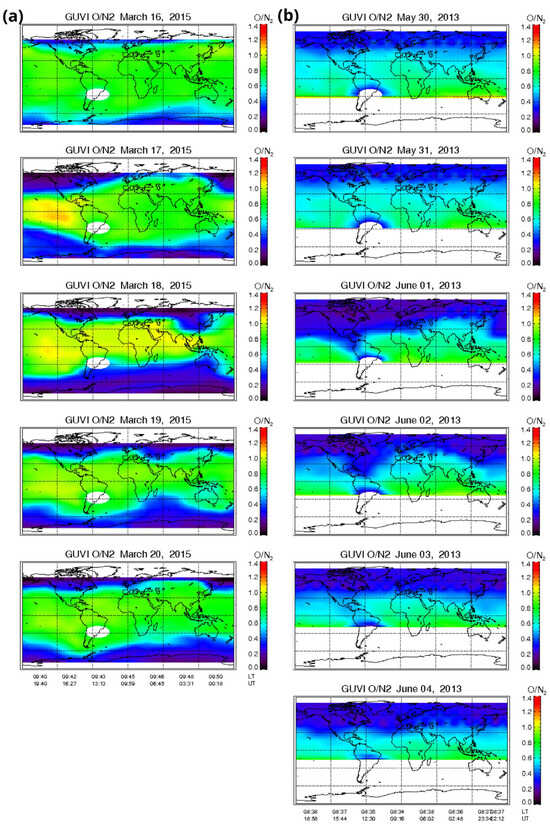
Figure 8.
TIMED/GUVI [O]/[N2] data for the (a) 2015 and (b) 2013 storm cases.
In Figure 9 and Figure 10, the rTEC data are portrayed for the selected period of the two geomagnetic storms. These data show the differences from the quiet-day values: red indicates an increase in electron density, blue indicates a decrease in electron density and green indicates no difference from the reference value.
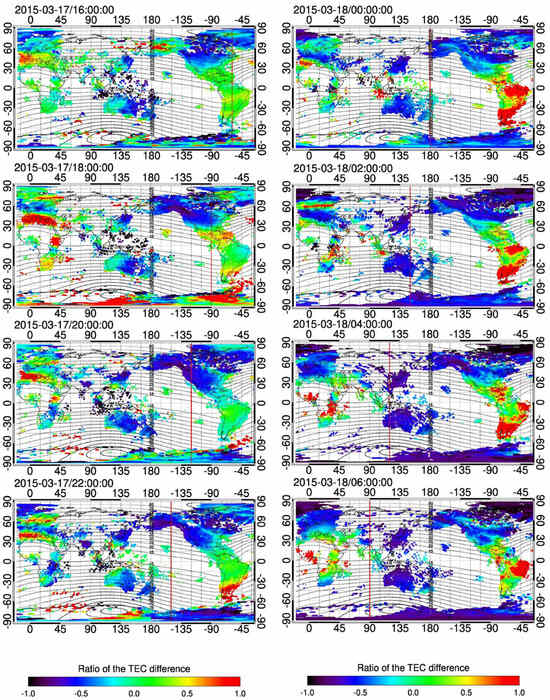
Figure 9.
The rTEC data for the ICME-driven storm case from 2015. We focus on the main phase between 16 UT on 17 and 06 UT on 18 March, when extremely depleted plasma, corresponding to negative deltafoF2, was detected at night at all the ionosonde stations shown in Figure 5. The local noon is indicated by a vertical red line in the plots [].
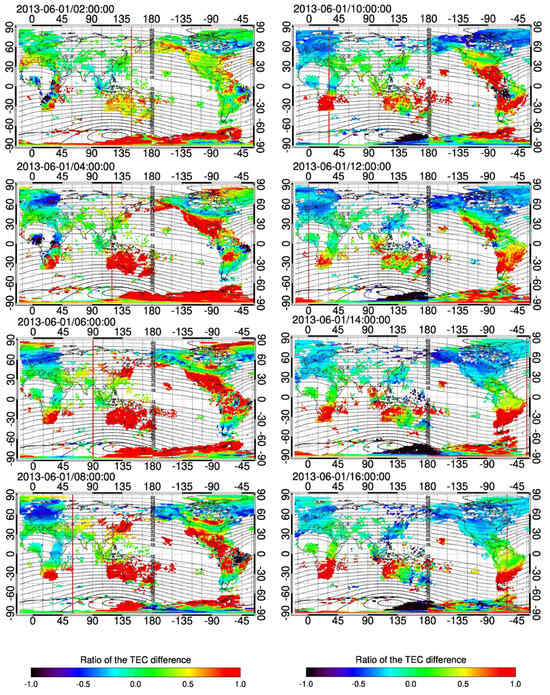
Figure 10.
The rTEC data for the CIR-driven storm case from 2013. Here, we show only the main phase between 02 and 16 UT on 1 June, when extremely depleted plasma was detected during the day in deltafoF2 at all the ionosonde stations in Figure 5. The local noon is indicated by a vertical red line in the plots [].
In Figure 9, the rTEC data for the ICME-driven event from 2015 are portrayed for a selected time interval, in the main phase of the storm, between 16 UT on 17 and 06 UT on 18 March. We show only the afternoon/night period, while in Figure 5, we have seen extremely depleted plasma in the F2-layer. The positive phase during the day over Europe is moving equatorward with time and from the auroral region a negative phase follows it. In our previous multi-instrumental study [], we proved that the equatorward movement of this negative phase region is linked to the midlatitude ionospheric trough (MIT), which is the ionospheric footprint of the plasmapause (PP).
In Figure 10, the rTEC data for the CIR-driven event from 2013 are shown, focusing on a selected time interval during the main phase of the storm between 02 and 16 UT on 1 June. From 04 UT, the negative phase started to move equatorward from the Scandinavian region and reached Africa around noon. The ionospheric plasma was depleted over the whole European region until 23:00 UT. The negative phase region started to move westward during the dawn hours of 2 June, and by 08 UT, it reached the quiet level (see these plots in the Supplementary Materials).
In Figure 11 and Figure 12, we plot the MUF(D) parameter (a) and the isodensity (b) data in both figures from the main and early recovery phases of the storms. In the foF2 parameter, in Figure 5 and Figure 6, we found the signatures of wavelike features (TADs); therefore, to prove their presence, we also analyzed the MUF and isodensity data. In these data, these wavelike features can be nicely seen. The main source of them is the auroral heating during the geomagnetic storm; therefore, we indicate the peaks in the AE index in these figures.
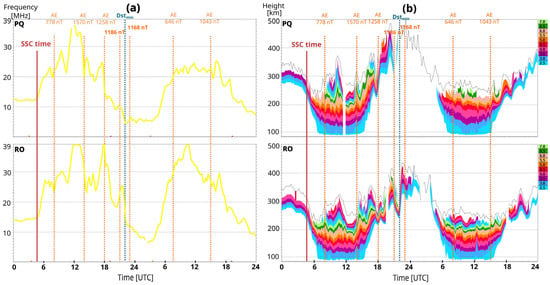
Figure 11.
The Digisonde MUF(D) (a) and isodensity (b) data for the ICME-driven storm case from 2015. Here, we show only the main and early recovery phase 17–18 March, when wavelike anomalies were observed in the foF2 data. With orange dotted lines, the AE index peaks are indicated with the values. The light blue dotted line shows the exact time of the Dst minimum value (22 UT), which shows the end of the main phase of the geomagnetic storm. The height variation of the 4.5 MHz (red line) is highlighted in the (b) plots.
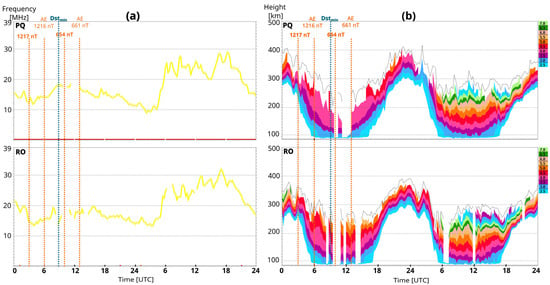
Figure 12.
The Digisonde MUF(D) (a) and isodensity (b) data for the CIR-driven storm case from 2013. Here, we show only the main and early recovery phase 1–2 June, when wavelike anomalies were observed in the foF2 data. With orange dotted lines, the AE index peaks are indicated with the values. The light blue dotted line shows the exact time of the Dst minimum value (9 UT), which shows the end of the main phase of the geomagnetic storm. The height variation of the 4.5 MHz (red line) is highlighted in the (b) plots.
In Figure 11, the ICME-driven case is shown, and both the MUF and the isodensity data show nice wavelike anomalies, which prove the ionospheric manifestation of TADs, generally called traveling ionospheric disturbances (TIDs) []. The direct distance between Pruhonice and Rome is 923.1 km. For the 2015 storm case, the maximal peek in RO at 12:00 in foF2 (with 12.475 MHz) happened 30 min after the peak in PQ at 11:30 (with 12.12 MHz), while the calculated speed for the observed TAD in Figure 5, Figure 10 and Figure 11 is ~512.8 m/s.
For the CIR-driven storm case (Figure 12), we do not see any TAD/TID signature, neither in the MUF nor in the isodensity data, in the main phase of the geomagnetic storm, just slightly in the early recovery phase with a low amplitude. The source of these wavelike anomalies cannot be directly connected to the geomagnetic storm, because several other physical process can cause such anomalies (see, for more, []).
4. Discussion
Despite the basic physics of the F2 mid-latitude ionosphere being known [], the impact of a single geomagnetic storm is currently not predictable due to the dependence of different factors: geomagnetic storm intensity, SSC time, LT, geomagnetic latitude, the past state of the thermosphere–ionosphere system and the past history of the geomagnetic activity.
Here, we have analyzed and discussed the possible mechanisms that lead to the processes in the ionospheric F2-layer in the European sector during different types of geomagnetic storms.
From the comparison of the observations from the two ionosondes located in Rome, we can conclude that the RO AIS and DPS ionosondes measure the same values; therefore, in the following figures, we have plotted only the data of the DPS Digisonde.
As another main objective of this study, we have analyzed three stations’ data from Europe during two geomagnetic storm events, one ICME-driven event and one CIR-driven event. For this purpose, we have calculated the deltafoF2 and deltahF2, which represent the storm-time values in percentages. In addition, for this purpose, we also checked the TIMED/GUVI measured [O]/[N2] ratio and the rTEC data. For the ICME-driven storm case, we have examined the background conditions: IMF Bz turned southward two times after the SSC, from 06 to 09 UT and between 12 and 06 UT of 18th March (for ca. 18 h), the SW speed oscillated between 550 and 650 km/s, the AE index maximum was almost 1600 nT at 13 UT, with a maximum Kp of 7.67 on 17th March in the main phase of the storm. The conditions during the CIR-driven storm were as follows: the IMF Bz had one long southward turning between 00 and 07 UT (7 h) on 1st June, the SW speed started to increase from 400 up to 680 km/s the same day from 06 to 12 UT and reached its maximum with 770 km/s on 2 June. This indicates the start of a long-lasting high-speed solar wind stream period (HSSW); therefore, by the CIR-event, we cannot speak about a recovery phase after the main phase of the geomagnetic storm, as indicated by Dst index, because during the HSSW continuous energy injection is present into the auroral region. The maximal Kp value was 7.00 at 06 UT, while in the AE index, the maximum was at 03 and 06 UT, with 1200 nT in the main phase of the geomagnetic storm (which lasted until 08 UT on 1 June).
In both cases, during the longer Bz southward turning period, the AE, Kp and Dst indices reached their maximal values, and in the ionosphere during these intervals, the ICME-driven storm caused a significant latitude-dependent positive ionospheric storm phase, which around the end of this Bz period turned extremely negative during the night hours.
TADs are connected to the energy injection into the auroral region during storms and generally propagate toward the equator with 600–750 m/s near 400 km altitude, but almost half this speed at 200 km with a horizontal wavelength of 1000–3000 km []. In certain cases, TADs can propagate into the opposite hemisphere. In the ionosphere, these TADs can be observed as large-scale traveling ionospheric disturbances (LSTIDs). For the St. Patrick’s Day storm, after the first increase in the AE index at 06–09 UT on 17 March, an foF2-positive phase in the three stations is observed more closely in time in Pruhonice and Sopron and with some delay in Rome, indicating the ionospheric passage of a TAD with ~512 m/s velocity (that value agrees with the literature []). During this storm, Polekh et al. [] and Nava et al. [] found the same positive effect at middle and low latitudes along 120° E longitude and found a similar equatorward movement of it with 460 m/s velocity. Lu et al. [] examined the 2015 storm with GNSS and model data, and they found equatorward propagating LSTIDs with 600–700 m/s in the GNSS TEC data over the European sector at 10° E. Therefore, we assume that the propagating TADs can be one source of the detected positive phase in the F2 region. The double peaks in the foF2 and deltafoF2 values (see Figure 4 and Figure 5) were also recorded during daytime, which most probably can be connected to the eastward PPEF related to the southward IMF Bz turning periods during the geomagnetic storm, as also concluded in the papers of [,,]. These positive peaks can also be called storm-enhanced density (SED) features after the literature, which in the past were called as “dusk effect” and can be generally categorized into three types: midlatitude SED [,,], tongue of ionization (TOI) [,] and SED plume []. Based on this categorization, our observed two daytime positive peaks can be considered midlatitude SED, which is formed due to the eastward PPEF: the E × B drift caused the uplift of the ionospheric plasma to higher altitudes, where the recombination rate decreased, and in the meantime, diffuses the plasma downward along the magnetic field lines []. This process results in the so-called super-fountain effect, which is not restricted to the equatorial anomaly region, as the caused plasma diffusion along the magnetic field lines can reach the midlatitude region, too []. Alongside the effect of the PPEFs, the storm-generated TADs can also contribute significantly to the midlatitude SED [,,], and in our examined case, the combination of these two processes most probably caused the observed positive peaks around noon and in the afternoon, so causing the midlatitude SED feature. In the meantime, the height of the F2-layer (h’F2 and deltahF2) starts to significantly increase during the afternoon/nighttime hours (from 17 UT), and it seems that the long-lasting energy injections into the auroral region (as can be seen in the AE index data in Figure 2) caused long wavelength TADs, leading to the F-layer uplift along magnetic field lines. The different storm-time processes in the thermosphere–ionosphere–plasmasphere system can start with some time delay at the same time. In this case, most probably, the uplift effect of the TAD (increase in the deltahF2) closely followed the shrinking of the plasmapause and so the equatorward propagation of the MIT as the result of the erosion effect of the fully evolved ring current, whose peak was at 22 UT in the Dst. The equatorward propagation of the MIT can be nicely seen in the rTEC data (see also paper []). The MIT was followed by severely depleted plasma in its poleward side during the whole night, as is observed in the deltafoF2 and rTEC data. The background mechanism is that the poleward side of the MIT was conjugated to the depleted outer magnetosphere (plasma trough), which caused the peeling of the ionospheric plasma [].
During the CIR-driven event right after the SSC (around 16:30 UT), a short duration southward turning of the IMF Bz was registered (Figure 1), which could start an eastward PPEF and result in the observed electron density peak at around 18 UT at PQ and SO and 20 UT at RO. After this episode, a slight negative phase is seen in Pruhonice and Sopron, while in Rome (lower latitude), a positive ionospheric storm phase is recorded from 19 UT on 1 June to 03 UT on 2 June. This was followed by a sharp decrease in the deltafoF2 data in all the stations during the Bz southward turning period, reaching its most negative value with −40% at the exact time when the Bz turned back northward around 08 UT on 01st June. For the CIR-driven 2013 June storm, we propose that in the deltafoF2 and rTEC data, we see the equatorward propagation of a morning MIT reaching its minimum at RO around 9 UT, as seen in the deltafoF2 (Figure 6). This is the reason why we see a slight latitude dependence during the night of 31 May and 1 June. It should be stressed that during summer months, the thermospheric circulation is pre-eminently equatorward and the disturbed thermospheric composition (with the depleted thermospheric [O]/[N2] ratio) is able to reach the Rome latitude [], which was most probably the main reason for the detected daytime deep negative phase as it is registered with TIMED/GUVI measurement (Figure 8) ([,,,,]). Beside the depleted O/N2 ratio, the increased temperature of the heated gas itself is also an important factor in the formation of a negative ionospheric storm phase []. The increase in temperature leads to an increase in the recombination coefficient, which causes a further electron density decrease []. Due to the intense energy injection into the auroral thermosphere during the day of 1 June as a result of the long-lasting HSSWs period (Figure 1), the resultant high temperature of thermospheric gas could indeed contribute to the significant electron density decrease detected in the F2-layer. In a future study, to validate our assumption, the Digisonde drift, zonal wind data, satellite electron and neutral density observations and temperature or Horizontal Wind Model 2007 (HWM07, []) data are required, which would show a westward plasma drift with ~400 m/s if this feature is linked to an MIT ([,]).
To highlight the main difference between the ionospheric effect of the two types of geomagnetic storms, it can be stated that the ICME-driven storms tend to trigger the formation of TADs (see Figure 11) due to the significant energy injections into the auroral region, which in conjunction with storm-induced PPEFs, lead to a significant positive phase in the main phase of the storm. As for the similarities, during both storms, in the aurora region-generated storm-induced meridional waves bring the composition disturbance to lower latitudes, inducing a significant daytime negative phase in the early recovery phase on 18 March 2015 and on 1 June 2013. We also noticed in the case of the ICME-driven storm that latitude-dependent ionospheric effects are seen as expected, while during the CIR-driven case, we do not see significant latitude dependence in the deltafoF2 parameter over the analyzed European ionosonde stations. However, this could be due to the different seasons: during summer, the daytime background and storm-time meridional circulation coincide with each other, which (in the case of June 2013 storm) allows the storm-time disturbed composition zone to reach lower latitudes (like Rome) more effectively.
5. Conclusions
As part of this study, we have compared three types of ionosonde instruments in Europe, namely the PQ DPS-4D, the SO VISRC-2 and the RO AIS-INGV. For this purpose, we have compared the foF2 and h’F2 values during quiet days and the deltafoF2 and the deltahF2 parameters during storm time. Another main objective was to determine the similarities and differences in the ionospheric deltafoF2 and deltahF2 parameters during an ICME- and a CIR-driven event. The main conclusions of our study are as follows:
- From the comparison of the data provided by the ionosondes, we can conclude that the RO AIS and DPS type of ionosonde measure the same values, and the correlation coefficient (R) values are between 0.9312 and 0.9987.
- The quiet mean foF2 and h’F2 curves from each ionosonde indicate that the instrument type does not result in any noticeable differences in the data. No significant latitude dependence was observed.
- Due to the SSC that characterized the ICME-driven storms, a TAD is launched on 17 March with ~512 m/s velocity, as seen in the ionospheric parameters across all the analyzed stations. This phenomenon is not observed during the other CIR-related geomagnetic storm.
- During southward IMF Bz periods, eastward PPEFs contributed to the observed positive electron density peaks, which are called midlatitude SEDs, in the deltafoF2 data: around 18 UT at PQ and SO and 20 UT at RO on 31 May and around noon and 17–18 UT on 17 March.
- The electron density variations in deltafoF2 show significant latitude dependence during the main and early recovery phase of the St. Patrick’s Day storm, while there is no latitude dependence in the data for the June 2013 storm. This difference may be attributed to the different seasons rather than the different drivers. During summer, the daytime background thermospheric circulation is equatorward and brings a disturbed composition up to the Rome latitude, while during the St. Patrick’s Day storm, the disturbed composition, with a decreased [O]/[N2] ratio, can be locked at the latitude of Pruhonice and Sopron.
- During both the CIR- and ICME-driven storms, the aurora region-generated storm-induced meridional waves transported the composition disturbance to lower latitudes, inducing significant daytime negative phase on 1 June 2013 and in the early recovery phase on 18 March 2015.
- The deltahF2 parameter shows latitude dependence when the F2-layer is uplifting due to the storm-time processes arising from the auroral region (equatorward TADs). This is observed during the night of 17/18 March and during the day of 1 June.
- The decrease in the [O]/[N2] ratio detected by TIMED/GUVI during daytime confirms that the negative storm observed in the electron density is due to a variation in the thermospheric composition, especially for the CIR-driven event on 1st June.
- The equatorward movement of the negative ionospheric storm phase is detected with rTEC, in agreement with the observed F2-layer plasma depletion in deltafoF2, which indicates the presence of dawn/morning MIT for the CIR-driven event. This statement requires validation with other data sources, such as Digisonde drift and satellite data.
Supplementary Materials
The following supporting information can be downloaded at https://www.mdpi.com/article/10.3390/universe10090344/s1.
Author Contributions
K.A.B. was the main writer of the article, which involved the preparation of the event, manual scaling of ionosonde data, figure making and discussion of the results. V.B. helped in the preparation of the manuscript and reviewed the paper. L.P., D.S., C.S. and A.I. provided manually scaled ionosonde data from the Rome station and, along with Á.K., provided ideas and reviewed some parts of the manuscript. Therefore, every author of this manuscript contributed substantially to this study. All authors have read and agreed to the published version of the manuscript.
Funding
The contribution of V.B. was supported by OTKA, Hungarian Scientific Research Fund (grant no. PD 141967) of the National Research, Development and Innovation Office (NKFIH) and by Bolyai Fellowship (GD, no. BO/00461/21). Furthermore, this work was supported by Hungarian funding no. SA-95/2021.
Data Availability Statement
The data used in this study are mostly publicly available. The SC time are from the following: GFZ Potsdam, Germany: https://www.gfz-potsdam.de/kp-index and ISGI, Spain (International Service of Geo-magnetic Indices): http://isgi.unistra.fr/data_download.php. The ICME source dates were from these sites: https://kauai.ccmc.gsfc.nasa.gov/CMEscoreboard/; http://www.srl.caltech.edu/ACE/ASC/DATA/level3/icmetable2.htm. The CIR, HSS catalogues, which were used for this analysis, are available on the https://www.helcats-fp7.eu/ and https://helioforecast.space/sircat websites. The solar and geomagnetic indexes are from https://omniweb.gsfc.nasa.gov/form/dx1.html websites and the Dst, AE index and Dstmin times are from http://wdc.kugi.kyoto-u.ac.jp/wdc/Sec3.html and OMNIWeb (https://omniweb.gsfc.nasa.gov/form/dx1.html sites. For the ionosonde data at the Sopron station, see the following websites: http://iono.nck.ggki.hu/ionogif/latest.html and http://reec.hu/iono.php (all accessed on 27 May 2024).
Acknowledgments
We thank the data centers (OMNIWEB and WDC for Geomagnetism, Kyoto) and the Széchenyi István Geophysical Observatory at Nagycenk, Hungary, Rome (RO041; RM041), and Pruhonice (PQ052) stations for supplying high-quality ionosonde and Digisonde data for the research. The SSC data are partly from Observatori de l’Ebre (OE, Spain). Data of the observatories have been obtained from the INTERMAGNET source. We thank the national institutes that support them and INTERMAGNET for promoting high standards of magnetic observatory practice. (www.intermagnet.org accessed on 22 August 2024). The GUVI instrument was designed and built by the Aerospace Corporation and Johns Hopkins University. The principal investigator is Andrew B. Christensen and the chief scientist and co-PI is Larry J. Paxton. The GUVI data used here are provided through support from the NASA MO&DA program. GNSS RINEX files for the GNSS-TEC processing are provided from many organizations listed by the webpage (http://stdb2.isee.nagoya-u.ac.jp/GPS/GPS-TEC/gnss_provider_list.html accessed on 22 August 2024). Also, we are grateful to the reviewers for their valuable advice, which improved our article.
Conflicts of Interest
The authors declare no conflicts of interest.
References
- Smith, E.J.; Wolfe, J.H. Observations of interaction regions and corotating shocks between one and five AU: Pioneers 10 and 11. Geophys. Res. Lett. 1976, 3, 137–140. [Google Scholar] [CrossRef]
- Crooker, N.U.; Cliver, E.W. Postmodern view of M-regions. J. Geophys. Res. 1994, 99, 23383–23390. [Google Scholar] [CrossRef]
- Burns, A.G.; Solomon, S.C.; Wang, W.; Qian, L.; Zhang, Y.; Paxton, L.J. Daytime climatology of ionospheric NmF2 and hmF2 from COSMIC data. J. Geophys. Res. 2012, 117, 9315. [Google Scholar] [CrossRef]
- Kamide, Y. Interplanetary and magnetospheric electric fields during geomagnetic storms: What is more important, steady-state fields or fluctuating fields? J. Atmos. Sol. Terr. Phys. 2001, 63, 413–420. [Google Scholar] [CrossRef]
- Buresova, D.; Lastovicka, J.; Hejda, P.; Bochnicek, J. Ionospheric disturbances under low solar activity conditions. Adv. Space Res. 2014, 54, 185–196. [Google Scholar] [CrossRef]
- Chen, G.; Xu, J.; Wang, W.; Lei, J.; Burns, A.G. A comparison of the effects of CIR- and CME-induced geomagnetic activity on thermospheric densities and spacecraft orbits: Case studies. J. Geophys. Res. 2012, 117, 8315. [Google Scholar] [CrossRef]
- Denton, M.H.; Borovsky, J.E.; Skoug, R.M.; Thomsen, M.F.; Lavraud, B.; Henderson, M.G.; McPherron, R.L.; Zhang, J.C.; Liemohn, M.W. Geomagnetic storms driven by ICME- and CIR-dominated solar wind. J. Geophys. Res. 2006, 111, 7. [Google Scholar] [CrossRef]
- Tsurutani, B.T.; Lakhina, G.S.; Sen, A.; Hellinger, P.; Glassmeier, K.; Mannucci, A.J. A Review of Alfvénic Turbulence in High-Speed Solar Wind Streams: Hints from Cometary Plasma Turbulence. J. Geophys. Res. Space Phys. 2018, 123, 2458–2492. [Google Scholar] [CrossRef]
- Tsurutani, B.T.; Gonzalez, W.D.; Gonzalez, A.L.C.; Tang, F.; Arballo, J.K.; Okada, M. Interplanetary origin of geomagnetic activity in the declining phase of the solar cycle. J. Geophys. Res. 1995, 100, 21717–21733. [Google Scholar] [CrossRef]
- Hajra, R.; Echer, E.; Tsurutani, B.T.; Gonzalez, W.D. Solar cycle dependence of High-Intensity Long-Duration Continuous AE Activity (HILDCAA) events, relativistic electron predictors? J. Geophys. Res. Space Phys. 2013, 118, 5626–5638. [Google Scholar] [CrossRef]
- Tsurutani, B.T.; Zank, G.P.; Sterken, V.J.; Shibata, K.; Nagai, T.; Mannucci, A.J.; Malaspina, D.M.; Lakhina, G.S.; Kanekal, S.G.; Hosokawa, K.; et al. Space Plasma Physics: A Review. IEEE Trans. Plasma Sci. 2022, 51, 1595–1655. [Google Scholar] [CrossRef]
- Li, Q.; Zhao., M.-X.; Le., G.-M. Properties of the Geomagnetic Storm Main Phase and the Corresponding Solar Wind Parameters on 21–22 October 1999. Universe 2022, 8, 346. [Google Scholar] [CrossRef]
- Gonzalez, W.D.; Joselyn, J.A.; Kamide, Y.; Kroehl, H.W.; Rostoker, G.; Tsurutani, B.T.; Vasyliunas, V.M. What is a geomagnetic storm? J. Geophys. Res. Space Phys. 1994, 99, 5771–5792. [Google Scholar] [CrossRef]
- Tsurutani, B.T.; Gonzalez, W.D.; Gonzalez, A.L.C.; Guarnieri, F.L.; Gopalswamy, N.; Grande, M.; Kamide, Y.; Kasahara, Y.; Lu, G.; Mann, I.; et al. Corotating solar wind streams and recurrent geomagnetic activity: A review. J. Geophys. Res. 2006, 111, A07S01. [Google Scholar] [CrossRef]
- Hansen, R.T.; Garcia, C.J.; Grognard, R.J.-M.; Sheridan, K.V. A Coronal Disturbance Observed Simultaneously with a White-Light Coronameter and the 80 MHz Culgoora Radioheliograph. Publ. Astron. Soc. Aust. 1971, 2, 57–60. [Google Scholar] [CrossRef]
- Nishida, A. Geomagnetic Diagnosis of the Magnetosphere; Springer: Berlin/Heidelberg, Germany, 1978; Volume 9. [Google Scholar] [CrossRef]
- Tsurutani, B.; Lakhina, G.; Verkhoglyadova, O.; Gonzalez, W.; Echer, E.; Guarnieri, F. A review of interplanetary discontinuities and their geomagnetic effects. J. Atmos. Sol. Terr. Phys. 2010, 73, 5–19. [Google Scholar] [CrossRef]
- Joselyn, J.A.; Tsurutani, B.T. Geomagnetic Sudden impulses and storm sudden commencements: A note on terminology. Eos Trans. Am. Geophys. Union 1990, 71, 1808–1809. [Google Scholar] [CrossRef]
- Chapman, S.; Ferraro, V.C.A. A new theory of magnetic storms. Terr. Magn. Atmos. Electr. 1931, 36, 77–97. [Google Scholar] [CrossRef]
- Tsurutani, B.T.; Gonzalez, W.D.; Tang, F.; Akasofu, S.I.; Smith, E.J. Origin of interplanetary southward magnetic fields responsible for major magnetic storms near solar maximum (1978–1979). J. Geophys. Res. 1988, 93, 8519–8531. [Google Scholar] [CrossRef]
- Tsurutani, B.; Gonzalez, W.; Zhou, X.-Y.; Lepping, R.; Bothmer, V. Properties of slow magnetic clouds. J. Atmos. Sol. Terr. Phys. 2004, 66, 147–151. [Google Scholar] [CrossRef]
- Timothy, A.F.; Krieger, A.S.; Vaiana, G.S. The structure and evolution of coronal holes. Sol. Phys. 1975, 42, 135–156. [Google Scholar] [CrossRef]
- Krieger, A.S.; Timothy, A.F.; Roelof, E.C. A coronal hole and its identification as the source of a high velocity solar wind stream. Sol. Phys. 1973, 29, 505–525. [Google Scholar] [CrossRef]
- Tsurutani, B.T.; Gonzalez, W.D.; Kamide, Y. Magnetic storms. Surv Geophys. 1997, 18, 363–383. [Google Scholar] [CrossRef]
- Richardson, I.G. Solar wind stream interaction regions throughout the heliosphere. Living Rev. Sol. Phys. 2018, 15, 1–95. [Google Scholar] [CrossRef]
- Chi, Y.; Shen, C.; Luo, B.; Wang, Y.; Xu, M. Geoeffectiveness of Stream Interaction Regions From 1995 to 2016. Space Weather 2018, 16, 1960–1971. [Google Scholar] [CrossRef]
- McGranaghan, R.; Knipp, D.J.; McPherron, R.L.; Hunt, L.A. Impact of equinoctial high-speed stream structures on thermospheric responses. Space Weather 2014, 12, 277–297. [Google Scholar] [CrossRef]
- Tsurutani, B.T.; Smith, E.J.; Pyle, K.R.; Simpson, J.A. Energetic protons accelerated at corotating shocks: Pioneer 10 and 11 observations from 1 to 6 AU. J. Geophys. Res. 1982, 87, 7389–7404. [Google Scholar] [CrossRef]
- Allen, R.C.; Ho, G.C.; Jian, L.K.; Mason, G.M.; Vines, S.K.; Lario, D. Predictive Capabilities and Limitations of Stream Interaction Region Observations at Different Solar Longitudes. Space Weather 2020, 18, e2019SW002437. [Google Scholar] [CrossRef]
- Mendillo, M.; Narvaez, C. Ionospheric storms at geophysically-equivalent sites—Part 1: Storm-time patterns for sub-auroral ionospheres. Ann. Geophys. 2009, 27, 1679–1694. [Google Scholar] [CrossRef]
- Mendillo, M.; Narvaez, C. Ionospheric storms at geophysically-equivalent sites—Part 2: Local time storm patterns for sub-auroral ionospheres. Ann. Geophys. 2010, 28, 1449–1462. [Google Scholar] [CrossRef]
- Gopalswamy, N. Solar connections of geoeffective magnetic structures. J. Atmos. Sol. Terr. Phys. 2008, 70, 2078–2100. [Google Scholar] [CrossRef]
- Berényi, K.A.; Opitz, A.; Dálya, Z.; Kis, Á.; Barta, V. Impact of ICME- and SIR/CIR-Driven Geomagnetic Storms on the Ionosphere over Hungary. Atmosphere 2023, 14, 1377. [Google Scholar] [CrossRef]
- Turner, N.E.; Cramer, W.D.; Earles, S.K.; Emery, B.A. Geoefficiency and energy partitioning in CIR-driven and CME-driven storms. J. Atmos. Sol. Terr. Phys. 2009, 71, 1023–1031. [Google Scholar] [CrossRef]
- Emery, B.A.; Richardson, I.G.; Evans, D.S.; Rich, F.J. Solar wind structure sources and periodicities of auroral electron power over three solar cycles. J. Atmos. Sol. Terr. Phys. 2009, 71, 1157–1175. [Google Scholar] [CrossRef]
- Meng, X.; Tsurutani, B.T.; Mannucci, A.J. The Solar and Interplanetary Causes of Superstorms (Minimum Dst ≤ −250 nT) During the Space Age. J. Geophys. Res. Space Phys. 2019, 124, 3926–3948. [Google Scholar] [CrossRef]
- Tsurutani, B.T.; Ho, C.M.; Arballo, J.K.; Goldstein, B.E.; Balogh, A. Large amplitude IMF fluctuations in corotating interaction regions: Ulysses at midlatitudes. Geophys. Res. Lett. 1995, 22, 3397–3400. [Google Scholar] [CrossRef]
- Tsurutani, B.T.; Gonzalez, W.D. The cause of high-intensity long-duration continuous AE activity (HILDCAAs): Interplanetary Alfvén wave trains. Planet. Space Sci. 1987, 35, 405–412. [Google Scholar] [CrossRef]
- Berényi, K.A.; Heilig, B.; Urbář, J.; Kouba, D.; Kis, Á.; Barta, V. Comprehensive analysis of the ionospheric response to the largest geomagnetic storms from solar cycle 24 over Europe. Front. Astron. Space Sci. 2023, 10, 1092850. [Google Scholar] [CrossRef]
- Nava, B.; Rodríguez-Zuluaga, J.; Alazo-Cuartas, K.; Kashcheyev, A.; Migoya-Orué, Y.; Radicella, S.; Amory-Mazaudier, C.; Fleury, R. Middle- and low-latitude ionosphere response to 2015 St. Patrick’s Day geomagnetic storm. J. Geophys. Res. Space Phys. 2016, 121, 3421–3438. [Google Scholar] [CrossRef]
- Tsurutani, B.T.; Verkhoglyadova, O.P.; Mannucci, A.J.; Saito, A.; Araki, T.; Yumoto, K.; Tsuda, T.; Abdu, M.A.; Sobral, J.H.A.; Gonzalez, W.D.; et al. Prompt penetration electric fields (PPEFs) and their ionospheric effects during the great magnetic storm of 30–31 October 2003. J. Geophys. Res. Space Phys. 2008, 113, A05311. [Google Scholar] [CrossRef]
- Rishbeth, H.; Barron, D. Equilibrium electron distributions in the ionospheric F2-layer. J. Atmos. Terr. Phys. 1960, 18, 234–252. [Google Scholar] [CrossRef]
- Pirog, O.; Polekh, N.; Tashchilin, A.; Romanova, E.; Zherebtsov, G. Response of ionosphere to the great geomagnetic storm of September 1998: Observation and modeling. Adv. Space Res. 2006, 37, 1081–1087. [Google Scholar] [CrossRef]
- Danilov, A. Ionospheric F-region response to geomagnetic disturbances. Adv. Space Res. 2013, 52, 343–366. [Google Scholar] [CrossRef]
- Immel, T.J.; Mannucci, A.J. Ionospheric redistribution during geomagnetic storms. J. Geophys. Res. Space Phys. 2013, 118, 7928–7939. [Google Scholar] [CrossRef] [PubMed]
- Mendillo, M.; Klobuchar, J.A.; Hajeb-Hosseinieh, H. Ionospheric disturbances: Evidence for the contraction of the plasmasphere during severe geomagnetic storms. Planet. Space Sci. 1974, 22, 223–236. [Google Scholar] [CrossRef]
- Heilig, B.; Stolle, C.; Kervalishvili, G.; Rauberg, J.; Miyoshi, Y.; Tsuchiya, F.; Kumamoto, A.; Kasahara, Y.; Shoji, M.; Nakamura, S.; et al. Relation of the Plasmapause to the Midlatitude Ionospheric Trough, the Sub-Auroral Temperature Enhancement and the Distribution of Small-Scale Field Aligned Currents as Observed in the Magnetosphere by THEMIS, RBSP, and Arase, and in the Topside Ionosphere by Swarm. J. Geophys. Res. Space Phys. 2022, 127, e2021JA029646. [Google Scholar] [CrossRef]
- Lanzerotti, L.J.; Cogger, L.L.; Mendillo, M. Latitude dependence of ionosphere total electron content: Observations during sudden commencement storms. J. Geophys. Res. 1975, 80, 1287–1306. [Google Scholar] [CrossRef]
- Turunen, T.; Liszka, L. Comparison of simultaneous satellite measurements of auroral particle precipitation with bottomside ionosonde measurements of the electron density in the F-region. J. Atmospheric Terr. Phys. 1972, 34, 365–372. [Google Scholar] [CrossRef]
- Rodger, A.; Brace, L.; Hoegy, W.; Winningham, J. The poleward edge of the mid-latitude trough—Its formation, orientation and dynamics. J. Atmos. Terr. Phys. 1986, 48, 715–728. [Google Scholar] [CrossRef]
- Voiculescu, M.; Nygrén, T.; Aikio, A.; Kuula, R. An olden but golden EISCAT observation of a quiet-time ionospheric trough. J. Geophys. Res. Space Phys. 2010, 115, 10315. [Google Scholar] [CrossRef]
- He, M.; Liu, L.; Wan, W.; Zhao, B. A study on the nighttime midlatitude ionospheric trough. J. Geophys. Res. Space Phys. 2011, 116, 5315. [Google Scholar] [CrossRef]
- Liu, Y.; Xiong, C. Morphology Evolution of the Midlatitude Ionospheric Trough in Nighttime Under Geomagnetic Quiet Conditions. J. Geophys. Res. Space Phys. 2020, 125, e2019JA027361. [Google Scholar] [CrossRef]
- Aa, E.; Zou, S.; Erickson, P.J.; Zhang, S.; Liu, S. Statistical Analysis of the Main Ionospheric Trough Using Swarm in Situ Measurements. J. Geophys. Res. Space Phys. 2020, 125, e2019JA027583. [Google Scholar] [CrossRef]
- Karpachev, A.T. Variations in the Winter Troughs’ Position with Local Time, Longitude, and Solar Activity in the Northern and Southern Hemispheres. J. Geophys. Res. Space Phys. 2019, 124, 8039–8055. [Google Scholar] [CrossRef]
- Rishbeth, H.; Field, P. Latitude and solar-cycle patterns in the response of the ionosphere F2-layer to geomagnetic activity. Adv. Space Res. 1997, 20, 1689–1692. [Google Scholar] [CrossRef]
- Prolss, G.W. Physics of the Earth’s Space Environment: An Introduction; Springer: Berlin/Heidelberg, Germany, 2004. [Google Scholar] [CrossRef]
- Buonsanto, M. Ionospheric Storms—A Review. Space Sci. Rev. 1999, 88, 563–601. [Google Scholar] [CrossRef]
- Mendillo, M. Storms in the ionosphere: Patterns and processes for total electron content. Rev. Geophys. 2006, 44, 1–47. [Google Scholar] [CrossRef]
- Kumar, E.A.; Kumar, S. Geomagnetic Storm Effect on F2-Region Ionosphere during 2012 at Low- and Mid-Latitude-Latitude Stations in the Southern Hemisphere. Atmosphere 2022, 13, 480. [Google Scholar] [CrossRef]
- Burešová, D.; Laštovička, J. Pre-storm enhancements of foF2 above Europe. Adv. Space Res. 2007, 39, 1298–1303. [Google Scholar] [CrossRef]
- Danilov, A.D.; Lastovicka, J. Effects of geomagnetic storms on the ionosphere and atmosphere. Int. J. Geomagn. Aeron. 2001, 2, 209–224. [Google Scholar]
- Zhai, C.; Tang, S.; Peng, W.; Cheng, X.; Zheng, D. Driver of the Positive Ionospheric Storm over the South American Sector during 4 November 2021 Geomagnetic Storm. Remote Sens. 2022, 15, 111. [Google Scholar] [CrossRef]
- Bojilova, R.; Mukhtarov, P. Response of the electron density profiles to geomagnetic disturbances in January 2005. Stud. Geophys. et Geod. 2019, 63, 436–454. [Google Scholar] [CrossRef]
- Sato, T. Disturbances in the Ionospheric F2 Region Associated with Geomagnetic Storms II. Middle Latitudes. J. Geomagn. Geoelectr. 1957, 9, 1–22. [Google Scholar] [CrossRef]
- Matsushita, S. A study of the morphology of ionospheric storms. J. Geophys. Res. 1959, 64, 305–321. [Google Scholar] [CrossRef]
- Zuccheretti, E.; Tutone, G.; Sciacca, U.; Bianchi, C.; Baskaradas, J.A. The new AIS-INGV digital ionosonde. Ann. Geophys. 2010, 46, 647–659. [Google Scholar] [CrossRef]
- Romano, V.; Baskaradas, J.A.; Doumaz, F.; Pezzopane, M.; Sciacca, U.; Zuccheretti, E. The New AIS-INGV Ionosonde at Italian Antarctic Observatory. Available online: https://www.earth-prints.org/handle/2122/4079 (accessed on 30 May 2024).
- Krasheninnikov, I.; Pezzopane, M.; Scotto, C. Application of Autoscala to ionograms recorded by the AIS-Parus ionosonde. Comput. Geosci. 2010, 36, 628–635. [Google Scholar] [CrossRef]
- Upper Atmosphere Physics and Radiopropagation Working Group; Marcocci, C.; Pezzopane, M.; Pica, E.; Romano, V.; Sabbagh, D.; Scotto, C.; Zuccheretti, E. Electronic Space Weather Upper Atmosphere Database (eSWua)-HF Data, Version 1.0; Istituto Nazionale di Geofisica e Vulcanologia (INGV): Rome, Italy. Available online: https://data.ingv.it/dataset/226#additional-metadata (accessed on 22 August 2024).
- Upper Atmosphere Physics and Radiopropagation Working Group; Cossari, A.; Fontana, G.; Marcocci, C.; Pau, S.; Pezzopane, M.; Pica, E.; Zuccheretti, E. Electronic Space Weather Upper Atmosphere Database (eSWua)-HF Validated Data, Version 1.0; Istituto Nazionale di Geofisica e Vulcanologia (INGV): Rome, Italy. Available online: https://data.ingv.it/en/dataset/224#additional-metadata (accessed on 22 August 2024).
- Christensen, A.B.; Paxton, L.J.; Avery, S.; Craven, J.; Crowley, G.; Humm, D.C.; Kil, H.; Meier, R.R.; Meng, C.-I.; Morrison, D.; et al. Initial observations with the Global Ultraviolet Imager (GUVI) in the NASA TIMED satellite mission. J. Geophys. Res. 2003, 108, 1451. [Google Scholar] [CrossRef]
- Crowley, G.; Hackert, C.L.; Meier, R.R.; Strickland, D.J.; Paxton, L.J.; Pi, X.; Mannucci, A.; Christensen, A.B.; Morrison, D.; Bust, G.S.; et al. Global thermosphere-ionosphere response to onset of 20 November 2003 magnetic storm. J. Geophys. Res. 2006, 111, A10S18. [Google Scholar] [CrossRef]
- Berényi, K.; Barta, V.; Kis, Á. Midlatitude ionospheric F2-layer response to eruptive solar events-caused geomagnetic disturbances over Hungary during the maximum of the solar cycle 24: A case study. Adv. Space Res. 2018, 61, 1230–1243. [Google Scholar] [CrossRef]
- Barta, V.; Natras, R.; Srećković, V.; Koronczay, D.; Schmidt, M.; Šulic, D. Multi-instrumental investigation of the solar flares impact on the ionosphere on 05–06 December 2006. Front. Environ. Sci. 2022, 10, 1174. [Google Scholar] [CrossRef]
- Zhang, S.; Zhang, Y.; Wang, W.; Verkhoglyadova, O.P. Geospace system responses to the St. Patrick’s Day storms in 2013 and 2015. J. Geophys. Res. Space Phys. 2017, 122, 6901–6906. [Google Scholar] [CrossRef]
- Liu, J.; Wang, W.; Burns, A.; Yue, X.; Zhang, S.; Zhang, Y.; Huang, C. Profiles of ionospheric storm-enhanced density during the 17 March 2015 great storm. J. Geophys. Res. Space Phys. 2015, 121, 727–744. [Google Scholar] [CrossRef]
- Zhang, S.R.; Erickson, P.J.; Zhang, Y.; Wang, W.; Huang, C.; Coster, A.J.; Holt, J.M.; Foster, J.F.; Sulzer, M.; Kerr, R. Observations of ion-neutral coupling associated with strong electrodynamic disturbances during the 2015 St. Patrick’s Day storm. J. Geophys. Res. Space Phys. 2017, 122, 1314–1337. [Google Scholar] [CrossRef]
- Huang, C.; Xu, J.-Y.; Zhang, X.-X.; Liu, D.-D.; Yuan, W.; Jiang, G.-Y. Mid-latitude thermospheric wind changes during the St. Patrick’s Day storm of 2015 observed by two Fabry-Perot interferometers in China. Adv. Space Res. 2018, 61, 1873–1879. [Google Scholar] [CrossRef]
- Prikryl, P.; Ghoddousi-Fard, R.; Weygand, J.M.; Viljanen, A.; Connors, M.; Danskin, D.W.; Jayachandran, P.T.; Jacobsen, K.S.; Andalsvik, Y.L.; Thomas, E.G.; et al. GPS phase scintillation at high latitudes during the geomagnetic storm of 17–18 March 2015. J. Geophys. Res. Space Phys. 2016, 121, 10448–10465. [Google Scholar] [CrossRef]
- Li, W.; Ma, Q.; Thorne, R.M.; Bortnik, J.; Zhang, X.; Li, J.; Baker, D.N.; Reeves, G.D.; Spence, H.E.; Kletzing, C.A.; et al. Radiation belt electron acceleration during the 17 March 2015 geomagnetic storm: Observations and simulations. J. Geophys. Res. Space Phys. 2016, 121, 5520–5536. [Google Scholar] [CrossRef]
- Nayak, C.; Tsai, L.-C.; Su, S.-Y.; Galkin, I.; Caton, R.; Groves, K. Suppression of ionospheric scintillation during St. Patrick’s Day geomagnetic super storm as observed over the anomaly crest region station Pingtung, Taiwan: A case study. Adv. Space Res. 2017, 60, 396–405. [Google Scholar] [CrossRef]
- Nayak, C.; Tsai, L.; Su, S.; Galkin, I.A.; Tan, A.T.K.; Nofri, E.; Jamjareegulgarn, P. Peculiar features of the low-latitude and midlatitude ionospheric response to the St. Patrick’s Day geomagnetic storm of 17 March 2015. J. Geophys. Res. Space Phys. 2016, 121, 7941–7960. [Google Scholar] [CrossRef]
- Astafyeva, E.; Zakharenkova, I.; Förster, M. Ionospheric response to the 2015 St. Patrick’s Day storm: A global multi-instrumental overview. J. Geophys. Res. Space Phys. 2015, 120, 9023–9037. [Google Scholar] [CrossRef]
- Wu, C.C.; Liou, K.; Lepping, R.P.; Hutting, L.; Plunkett, S.; Howard, R.A. The first super geomagnetic storm of solar cycle 24: ‘The St. Patrick’s day event (17 March 2015)’ Global Data Systems for the Study of Solar-Terrestrial Variability 3. Space science. Earth Planets Space 2016, 68, 151. [Google Scholar] [CrossRef]
- Forbes, J.M. Dynamics of the Thermosphere. J. Meteorol. Soc. Jpn. Ser. II 2007, 85B, 193–213. [Google Scholar] [CrossRef]
- Shinbori, A.; Otsuka, Y.; Sori, T.; Tsugawa, T.; Nishioka, M. Temporal and Spatial Variations of Total Electron Content Enhancements During a Geomagnetic Storm on 27 and 28 September 2017. J. Geophys. Res. Space Phys. 2020, 125, e2019JA026873. [Google Scholar] [CrossRef]
- Zhang, S.R.; Erickson, P.J.; Coster, A.J.; Rideout, W.; Vierinen, J.; Jonah, O.; Goncharenko, L.P. Subauroral and Polar Traveling Ionospheric Disturbances During the 7–9 September 2017 Storms. Space Weather 2019, 17, 1748–1764. [Google Scholar] [CrossRef]
- Polekh, N.; Zolotukhina, N.; Kurkin, V.; Zherebtsov, G.; Shi, J.; Wang, G.; Wang, Z. Dynamics of ionospheric disturbances during the 17–19 March 2015 geomagnetic storm over East Asia. Adv. Space Res. 2017, 60, 2464–2476. [Google Scholar] [CrossRef]
- Lu, G.; Zakharenkova, I.; Cherniak, I.; Dang, T. Large-Scale Ionospheric Disturbances During the 17 March 2015 Storm: A Model-Data Comparative Study. J. Geophys. Res. Space Phys. 2020, 125, e2019JA027726. [Google Scholar] [CrossRef]
- Tsurutani, B.; Mannucci, A.; Iijima, B.; Abdu, M.A.; Sobral, J.H.A.; Gonzalez, W.; Guarnieri, F.; Tsuda, T.; Saito, A.; Yumoto, K.; et al. Global dayside ionospheric uplift and enhancement associated with interplanetary electric fields. J. Geophys. Res. 2004, 109, A08302. [Google Scholar] [CrossRef]
- Mannucci, A.J.; Tsurutani, B.T.; Iijima, B.A.; Komjathy, A.; Saito, A.; Gonzalez, W.D.; Guarnieri, F.L.; Kozyra, J.U.; Skoug, R. Dayside global ionospheric response to the major interplanetary events of October 29–30, 2003 “Halloween Storms”. Geophys. Res. Lett. 2005, 32. [Google Scholar] [CrossRef]
- Heelis, R.A.; Coley, W.R. Variations in the low- and middle-latitude topside ion concentration observed by DMSP during superstorm events. J. Geophys. Res. 2007, 112, 1–4. [Google Scholar] [CrossRef]
- Foster, J.C.; Coster, A.J.; Erickson, P.J.; Holt, J.M.; Lind, F.D.; Rideout, W.; McCready, M.; van Eyken, A.; Barnes, R.J.; Greenwald, R.A.; et al. Multiradar observations of the polar tongue of ionization. J. Geophys. Res. 2005, 110, 9–31. [Google Scholar] [CrossRef]
- Foster, J.C. Storm time plasma transport at middle and high latitudes. J. Geophys. Res. 1993, 98, 1675–1689. [Google Scholar] [CrossRef]
- Lu, G.; Goncharenko, L.P.; Richmond, A.D.; Roble, R.G.; Aponte, N. A dayside ionospheric positive storm phase driven by neutral winds. J. Geophys. Res. 2008, 113, 8304. [Google Scholar] [CrossRef]
- Lin, C.H.; Richmond, A.D.; Heelis, R.A.; Bailey, G.J.; Lu, G.; Liu, J.Y.; Yeh, H.C.; Su, S. Theoretical study of the low- and midlatitude ionospheric electron density enhancement during the October 2003 superstorm: Relative importance of the neutral wind and the electric field. J. Geophys. Res. 2005, 110, 12312. [Google Scholar] [CrossRef]
- Balan, N.; Shiokawa, K.; Otsuka, Y.; Kikuchi, T.; Lekshmi, D.V.; Kawamura, S.; Yamamoto, M.; Bailey, G.J. A physical mechanism of positive ionospheric storms at low latitudes and midlatitudes. J. Geophys. Res. 2010, 115, A02304. [Google Scholar] [CrossRef]
- Ippolito, A.; Perrone, L.; Plainaki, C.; Cesaroni, C. Investigating the foF2 variations at the Ionospheric Observatory of Rome during different solar cycles minimums and levels of geomagnetic activity. J. Space Weather. Space Clim. 2020, 10, 52. [Google Scholar] [CrossRef]
- Prölss, G.W.; von Zahn, U. Esro 4 Gas Analyzer results 2. Direct measurements of changes in the neutral composition during an ionospheric storm. J. Geophys. Res. 1974, 79, 2535–2539. [Google Scholar] [CrossRef]
- Mikhailov, A.V.; Skoblin, M.G.; Förster, M. Daytime F2-layer positive storm effect at middle and lower latitudes. Ann. Geophys. 1995, 13, 532–540. [Google Scholar] [CrossRef]
- Prölss, G.W. Ionospheric F-region storms. In Handbook of Atmospheric Electrodynamics; CRC Press: Boca Raton, FL, USA, 1995; Volume 2, Chapter 8; pp. 195–248. Available online: https://cir.nii.ac.jp/crid/1570291225295033472 (accessed on 2 November 2022).
- Mikhailov, A.V.; Foster, J.G. Daytime thermosphere above Millstone Hill during severe geomagnetic storms. J. Geophys. Res. 1997, 102, 17275–17282. [Google Scholar] [CrossRef]
Disclaimer/Publisher’s Note: The statements, opinions and data contained in all publications are solely those of the individual author(s) and contributor(s) and not of MDPI and/or the editor(s). MDPI and/or the editor(s) disclaim responsibility for any injury to people or property resulting from any ideas, methods, instructions or products referred to in the content. |
© 2024 by the authors. Licensee MDPI, Basel, Switzerland. This article is an open access article distributed under the terms and conditions of the Creative Commons Attribution (CC BY) license (https://creativecommons.org/licenses/by/4.0/).